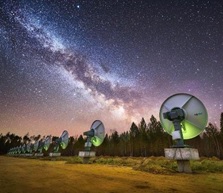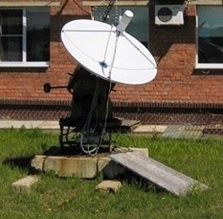Institute of Solar-Terrestrial Physics of Siberian Branch of Russian Academy of Sciences (ISTP SB RAS)
The Radio-Astrophysical Observatory
From ISTP SB RAS
(Difference between revisions)
| Revision as of 06:18, 15 November 2010 (edit) Admin (Talk | contribs) ← Previous diff |
Revision as of 08:27, 17 June 2021 (edit) (undo) Admin (Talk | contribs) Next diff → |
||
| Line 1: | Line 1: | ||
| - | The | + | The Radio-Astrophysical Observatory (RAO) is in the Tunka Valley that separates two ranges of the East Sayan, 220 km from Irkutsk (51°45′33″ N, 102°13′08″ E). The Observatory site survey ([https://goo.gl/maps/895pyjucMxabSPKw9 https://goo.gl/maps/895pyjucMxabSPKw9]) was determined by minimizing technogenous noise. At the moment, the main instruments are a radioheliograph and a suite of integral flux spectro-polarimeters. The RAO staff equals about 40, the operation time being 00–10 UT. |
| - | + | <center>[[Image:Ssrt1.jpg]]</center> | |
| - | + | ||
| - | [[Image: | + | |
| - | + | ||
| - | + | ||
| - | {| | + | {| |
| - | | | + | |- |
| - | [[Image: | + | |[[Image:Ssrt2.jpg|left]] |
| - | | | + | |<b>Mission:</b> |
| + | * studying solar corona heating, | ||
| + | * investigating solar flares, | ||
| + | * measuring coronal magnetic fields, | ||
| + | * monitoring coronal mass ejections, | ||
| + | * all-weather multiwave monitoring of solar activity, | ||
| + | * multiwave mapping of the Sun in the microwave range, | ||
| + | * monitoring the solar integral flux at a high spectral and temporal resolutions within a wide frequency range. | ||
| + | |- | ||
| + | |[[Image:Ssrt3.jpg|left]] | ||
| + | |<b>Instruments:</b> | ||
| + | * Siberian Solar Radio Telescope (SSRT) ([https://badary.iszf.irk.ru/ssrt.php https://badary.iszf.irk.ru/ssrt.php]); | ||
| + | * Siberian Radioheliograph ([https://badary.iszf.irk.ru/srhCorrPlot.php https://badary.iszf.irk.ru/srhCorrPlot.php]); | ||
| + | * Suite of Integral Flux Spectro-Polarimeters ([https://badary.iszf.irk.ru/spectropolarimeter_2_24.php https://badary.iszf.irk.ru/spectropolarimeter_2_24.php]). | ||
| + | |- | ||
| |} | |} | ||
| - | |||
| - | Step-by-step commissioning of the radio telescope was begun in the spring of 1981 and completed in 1984. With completion of adjustments of the N-S line in 1985, SSRT initiated an all-weather monitoring of solar activity in the one-dimensional mode with an angular resolution as high as 15" using both linear interferometers. The team of authors was awarded the Prize of the Russian Federation Government in the field of science and technology for the year 1996. | ||
| - | |||
| - | SSRT was put on the list of Russia's unique facilities. | ||
| - | |||
| - | Since 1992, SSRT has been involved in regular investigations of fine-structure active phenomena, such as spikes. Since 1993, the time resolution has been 15 ms. | ||
| - | |||
| - | During 1995-1996, SSRT incorporated two two-dimemsional modes: the projected correlation mode, and the combined additive-correlation mode. Two-dimensional mapping is done concurrently with one-dimensional images obtained in the additive mode. The correlation mode with high sensitivity permits low-constrast features on the Sun to be investigated. The additive-correlation mode ensures, at a sacrifice in sensitivity, a simultaneous construction of radio maps with a fast recording in the one-dimensional mode at the time resolution of 56 ms, which is important in observations of active processes when a reduction in sensitivity is not critical and the active region image can be obtained every minute. | ||
| - | [http://ssrt.iszf.irk.ru/index.shtml More..] | ||
| - | |||
| - | |||
| - | ==Archive of observation's results== | ||
| - | * [[Radio Burst Report]] | ||
| - | * [[Daily Image FITS]] | ||
| - | * [[SSRT Daily Images (5.7 GHz) (intensity)]] | ||
| - | * [[SSRT Daily Images (5.7 GHz) (polarization)]] | ||
| - | * [[SSRT Daily Images Movie (intensity)]] | ||
| - | * [[SSRT Daily Images Movie (polarization)]] | ||
| [[Category:Observatories]] | [[Category:Observatories]] | ||
| [[ru:Радиоастрофизическая обсерватория]] | [[ru:Радиоастрофизическая обсерватория]] | ||
Revision as of 08:27, 17 June 2021
The Radio-Astrophysical Observatory (RAO) is in the Tunka Valley that separates two ranges of the East Sayan, 220 km from Irkutsk (51°45′33″ N, 102°13′08″ E). The Observatory site survey (https://goo.gl/maps/895pyjucMxabSPKw9) was determined by minimizing technogenous noise. At the moment, the main instruments are a radioheliograph and a suite of integral flux spectro-polarimeters. The RAO staff equals about 40, the operation time being 00–10 UT.

Mission:
| |
Instruments:
|

